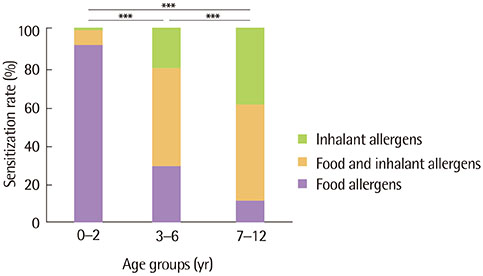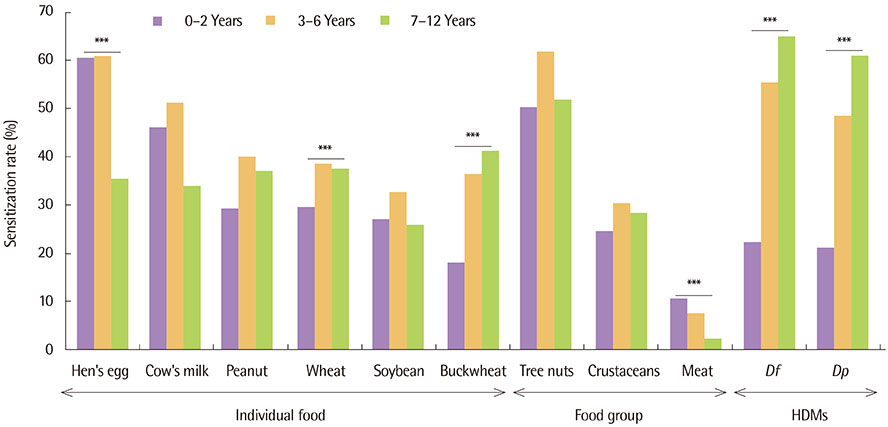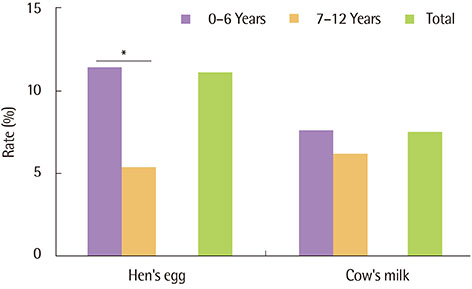Allergy Asthma Respir Dis.
2016 Jul;4(4):290-295. 10.4168/aard.2016.4.4.290.
Sensitization in children with atopic dermatitis: a single center study
- Affiliations
-
- 1Department of Pediatrics, Samsung Medical Center, Sungkyunkwan University School of Medicine, Seoul, Korea. jhlovechild@gmail.com
- 2Environmental Health Center for Atopic Diseases, Samsung Medical Center, Seoul, Korea.
- KMID: 2346759
- DOI: http://doi.org/10.4168/aard.2016.4.4.290
Abstract
- PURPOSE
There are few recent data regarding allergic sensitization of atopic dermatitis (AD) in Korea. The aim of this study was to investigate patterns of sensitization according to age and gender in children with AD.
METHODS
This retrospective study included 4,661 children with AD from 1998 to 2014. The serum specific IgE (sIgE) levels to egg white (EW), cow's milk (CM), peanut, wheat, soybean, buckwheat, tree nuts, crustaceans, meat, and house dust mites (HDMs) were reviewed. AD was categorized into the extrinsic (ADe) and intrinsic type (ADi) according to the presence or absence of sensitization. The proportion of patients with sIgE to EW or CM greater than the previously reported diagnostic decision point (DDP) was determined.
RESULTS
A total of 4,661 children (2,843 boys and 1,818 girls) were collected. We identified 1,857 of 2,663 children (69.7%) with the ADe type and 806 of 2,663 children (30.3%) with the ADi type. The sensitization rates increased with age (P<0.001). EW (59.3%) was the most commonly sensitized food, followed by CM (46.6%), peanut (32.2%), wheat (31.5%), soybean (28.1%), and buckwheat (23.7%). The most commonly sensitized food groups were tree nuts (56.7%) and crustaceans (28.3%). The rate of sensitization to HDMs was 40.1%. In addition, 11.1% and 7.5% of children had levels of sIgE to EW and CM, respectively, higher than the DDP.
CONCLUSION
The incidence of ADe among children with AD was 69.7% and increased with age. The most commonly sensitized food allergen was EW, followed by CM and peanut.
MeSH Terms
Figure
Cited by 2 articles
-
Current research status of pediatric atopic dermatitis in Korea
Bok Yang Pyun
Allergy Asthma Respir Dis. 2018;6(Suppl 1):S40-S43. doi: 10.4168/aard.2018.6.S1.S40.Proper allergen selection for serum specific IgE test in children
Yong Ju Lee, Hyeon-Jong Yang, Jong-Seo Yoon, Man-Yong Han, Chang Keun Kim, Jin Tack Kim
Allergy Asthma Respir Dis. 2018;6(5):237-240. doi: 10.4168/aard.2018.6.5.237.
Reference
-
1. Akdis CA, Akdis M, Bieber T, Bindslev-Jensen C, Boguniewicz M, Eigenmann P, et al. Diagnosis and treatment of atopic dermatitis in children and adults: European Academy of Allergology and Clinical Immunology/American Academy of Allergy, Asthma and Immunology/PRACTALL Consensus Report. Allergy. 2006; 61:969–987.
Article2. Ahn K, Kim J, Kwon HJ, Chae Y, Hahm MI, Lee KJ, et al. The prevalence of symptoms of asthma, allergic rhinoconjunctivitis, and eczema in Korean children: nationwide cross-sectional survey using complex sampling design. J Korean Med Assoc. 2011; 54:769–778.
Article3. Ricci G, Bendandi B, Bellini F, Patrizi A, Masi M. Atopic dermatitis: quality of life of young Italian children and their families and correlation with severity score. Pediatr Allergy Immunol. 2007; 18:245–249.
Article4. Lee SI, Kim J, Han Y, Ahn K. A proposal: atopic dermatitis organizer (ADO) guideline for children. Asia Pac Allergy. 2011; 1:53–63.
Article5. Schneider L, Tilles S, Lio P, Boguniewicz M, Beck L, LeBovidge J, et al. Atopic dermatitis: a practice parameter update 2012. J Allergy Clin Immunol. 2013; 131:295–299.e1-27.6. Leung DY, Guttman-Yassky E. Deciphering the complexities of atopic dermatitis: shifting paradigms in treatment approaches. J Allergy Clin Immunol. 2014; 134:769–779.
Article7. Pugliarello S, Cozzi A, Gisondi P, Girolomoni G. Phenotypes of atopic dermatitis. J Dtsch Dermatol Ges. 2011; 9:12–20.
Article8. Tokura Y. Extrinsic and intrinsic types of atopic dermatitis. J Dermatol Sci. 2010; 58:1–7.
Article9. Kim HS, Jung JI, Suh SB, Jung JA. Characteristics between IgE mediated and non-IgE mediated atopic dermatitis in children. Allergy Asthma Respir Dis. 2013; 1:339–343.
Article10. Park JH, Choi YL, Namkung JH, Kim WS, Lee JH, Park HJ, et al. Characteristics of extrinsic vs. intrinsic atopic dermatitis in infancy: correlations with laboratory variables. Br J Dermatol. 2006; 155:778–783.
Article11. Na HY, Song YH, Kim BJ, Yu JH, Hong SJ, Lee SY. Allergen sensitization of severe atopic dermatitis in children under 2 years. Pediatr Allergy Respir Dis. 2009; 19:146–154.12. Lee JS, Kim TH, Cho GL, Jung JA, Kim JH. The classification between IgE and non-IgE mediated atopic dermatitis in Korean children. Pediatr Allergy Respir Dis. 2005; 15:352–358.
Article13. Sicherer SH, Sampson HA. Food allergy: epidemiology, pathogenesis, diagnosis, and treatment. J Allergy Clin Immunol. 2014; 133:291–307.
Article14. Song TW, Kim KW, Kim WK, Kim JH, Kim HH, Park YM, et al. Guidelines for the oral food challenges in children. Pediatr Allergy Respir Dis. 2012; 22:4–20.
Article15. Song TW. Diagnostic decision points of specific IgE titers in patients with food allergy: are they appropriate in all clinical settings? Allergy Asthma Immunol Res. 2015; 7:309–311.
Article16. Sampson HA, Ho DG. Relationship between food-specific IgE concentrations and the risk of positive food challenges in children and adolescents. J Allergy Clin Immunol. 1997; 100:444–451.
Article17. Han YS, Chung SJ, Cho YY, Choi HM, Ahn KM, Lee SI. Analysis of the rate of sensitization to food allergen in children with atopic dermatitis. Korean J Community Nutr. 2004; 9:90–97.18. Han DK, Kim MK, Yoo JE, Choi SY, Kwon BC, Sohn MH, et al. Food sensitization in infants and young children with atopic dermatitis. Yonsei Med J. 2004; 45:803–809.
Article19. Hanifin JM, Rajka G. Diagnostic features of atopic dermatitis. Acta Derm Venereol (Stockh). 1980; 92:44–47.20. Severity scoring of atopic dermatitis: the SCORAD index. Consensus report of the European task force on atopic dermatitis. Dermatology. 1993; 186:23–31.21. Park M, Lee HY, Lee SI, Kim J, Ahn K. Positive conversion of specific IgE against house dust mite in children with atopic dermatitis under 24 months of age. Allergy Asthma Respir Dis. 2013; 1:350–356.
Article22. Schäfer T, Heinrich J, Wjst M, Adam H, Ring J, Wichmann HE. Association between severity of atopic eczema and degree of sensitization to aeroallergens in schoolchildren. J Allergy Clin Immunol. 1999; 104:1280–1284.
Article23. Kim J, Kim HY, Park MR, Choi J, Shim JY, Kim MJ, et al. Diagnostic decision points of specific IgE concentrations in Korean children with egg and cow's milk allergies. Allergy Asthma Immunol Res. 2015; 7:332–338.
Article24. Wüthrich B, Schmid-Grendelmeier P. The atopic eczema/dermatitis syndrome. Epidemiology, natural course, and immunology of the IgE-associated ("extrinsic") and the nonallergic ("intrinsic") AEDS. J Investig Allergol Clin Immunol. 2003; 13:1–5.25. Rho NK, Kim WS, Lee DY, Lee JH, Lee ES, Yang JM. Immunophenotyping of inflammatory cells in lesional skin of the extrinsic and intrinsic types of atopic dermatitis. Br J Dermatol. 2004; 151:119–125.
Article26. Choi SJ, Song MG, Sung WT, Lee DY, Lee JH, Lee ES, et al. Comparison of transepidermal water loss, capacitance and pH values in the skin between intrinsic and extrinsic atopic dermatitis patients. J Korean Med Sci. 2003; 18:93–96.
Article27. Ott H, Stanzel S, Ocklenburg C, Merk HF, Baron JM, Lehmann S. Total serum IgE as a parameter to differentiate between intrinsic and extrinsic atopic dermatitis in children. Acta Derm Venereol. 2009; 89:257–261.
Article28. Novembre E, Cianferoni A, Lombardi E, Bernardini R, Pucci N, Vierucci A. Natural history of "intrinsic" atopic dermatitis. Allergy. 2001; 56:452–453.
Article29. Baatenburg de Jong A, Dikkeschei LD, Brand PL. High prevalence of sensitization to aeroallergens in children 4 yrs of age or younger with symptoms of allergic disease. Pediatr Allergy Immunol. 2009; 20:735–740.
Article30. Wang IJ, Lin YT, Yang YH, Chen CL, Tsai YH, Chiang BL, et al. Correlation between age and allergens in pediatric atopic dermatitis. Ann Allergy Asthma Immunol. 2004; 93:334–338.
Article31. Kulig M, Bergmann R, Klettke U, Wahn V, Tacke U, Wahn U. Natural course of sensitization to food and inhalant allergens during the first 6 years of life. J Allergy Clin Immunol. 1999; 103:1173–1179.
Article32. Cho GR, Kim MJ, Kim JE, Jung JA. A comparison of the sensitization rate to the cow's milk, egg white and soybean in atopic dermatitis at a single institution in 2002 and 2007. Pediatr Allergy Respir Dis. 2008; 18:283–291.33. Fleischer DM. The natural history of peanut and tree nut allergy. Curr Allergy Asthma Rep. 2007; 7:175–181.
Article
- Full Text Links
- Actions
-
Cited
- CITED
-
- Close
- Share
- Similar articles
-
- Relationship between Allergen Sensitization and Frequency of Asthma in Preschool Atopic Dermatitis Children
- The Effect of Antigen Sensitization and Development of Respiratory Allergy Disease on Severity of Atopic Dermatitis
- Positive conversion of specific IgE against house dust mite in children with atopic dermatitis under 24 months of age
- A Comparison of the Sensitization Rate to the Cow's Milk, Egg White and Soybean in Atopic Dermatitis at A Single Institution in 2002 and 2007
- Age-related Changes in the Frequency of Intrinsic and Extrinsic Atopic Dermatitis: A Single-center Retrospective Study





